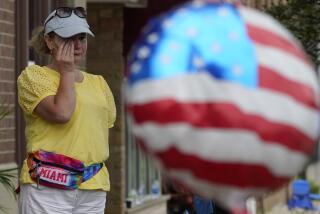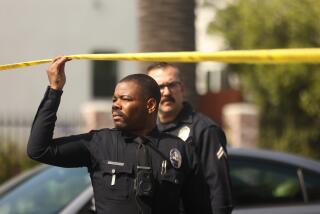Just Your Average Mayhem
- Share via
The statisticians calmly tell us that the recent rash of Southern California freeway shootings -- eight, with four people dead -- in the last few weeks is not far off the average, even if they’re spaced closer together than usual and the circumstances are harder to explain. Though no regional numbers are available, the city of Los Angeles averages a little more than 40 freeway shootings a year, with one to four fatalities over each of the last four years. This year’s 11 incidents so far in L.A., and two deaths, are close to that average.
Should we be reassured or horrified?
The shootings are in the news for their seeming inexplicability: few evident gang connections and in most cases no obvious road rage. The thread connecting the victims is that they’re mostly young males, a real risk factor in gang-plagued neighborhoods. After that, nothing. Not race, not type of car, not location, not time.
Sudden death on freeways in the middle of the day, as happened in three of the recent cases, weakens the mental armor that we all wear. It also sharpens the wit. In 1987, during the last notorious cluster of freeway shootings, the most talked-about bumper sticker read, “Honk If You’re Reloading.” Four years later, among the best-remembered scenes in the movie “L.A. Story” was a reflexive freeway shootout, car to car to car to car, after Steve Martin’s character fired on a bottled-water delivery truck.
On the serious end of the 1987 response, the California Highway Patrol added 150 officers. (Little chance of that now, with the state budget malaise.) Then-Assemblyman Burt Margolin (D-Los Angeles) tried to make it a felony to carry a gun in the passenger compartment of a car. When a National Rifle Assn. official charged that the bill would “effectively disarm” the law-abiding, Margolin retorted that highway shootings “are not of self-defense but of offense. We don’t have examples of people trying to defend themselves in cars.” Except, maybe, in Steve Martin movies. Margolin’s measure died under the withering NRA fire.
This time, at least so far, both wit and worry seem muted. No one knows quite what to worry about. This is nothing like Washington’s 2002 sniping attacks or Ohio’s 2003 freeway sniper, who apparently picked off cars from far away using a scope. The details and similarities in those two sniping series, the growing suspicion that a serial shooter was loose, gave the brain a grip for fear.
In Los Angeles, freeway shootings shock newcomers and perhaps deter tourists. Old-timers find the copycats who seem to be making sport of high-speed death too familiar. Police will most likely be foiled again unless the killers boast to the wrong person or a witness catches a license plate number.
Then, in a few months, it will be back to “normal.” No wonder noir humor became such a reliable staple of Hollywood.


